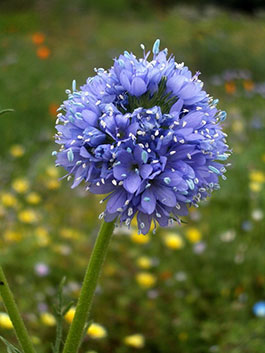Globe gilia in the Landscape

Aaron Anderson, Oregon State University
Scientfic Name: Gilia capitataCommon Name: Globe gilia
Description: Gilia capitata is a fast growing annual. Tall and dense, these wildflowers can grow up to 28 inches tall. They have green, finely dissected leaves that provide texture in a garden landscape. A member of the Phlox family, Gilia capitata has showy terminal inflorescences consisting of clustered blue to purple flowers shaped like a globe. The bloom period of this species is from spring through summer, and can be adjusted by altering the seeding date. This flower is drought tolerant and grows best in sunny, well-drained soils. These attributes make it an excellent candidate for wildflower meadows and garden edges that are given minimal maintenance.
Native Habitat: Gilia capitata is native to the western United States, mainly from Washington south into California, and east into the Rocky Mountain states of Idaho, Utah, New Mexico, and Arizona. It grows in well drained sandy to rocky sites and dry slopes at elevations ranging from 0 to 6,000 feet.
Cultural Requirement
Soil: Grows well in medium to course soil, especially in sandy and rocky soil. Well drained soil with a neutral pH (6.0-7.0) is preferable.
Moisture Tolerance: Moist to dry, well-drained soil. Mature plants tolerate drought and warm conditions.
Sun/Shade/Preference: Grows well in full sun, but will also tolerate light shade.
Transplanting: If seeded into flats, Gilia capitata can be transplanted outdoors. However, since it is a hearty annual species, seeding directly into the garden is preferable.
Propagation: Easily grown from seed. No stratification or scarification is required (though two weeks of cold stratification increases germination). Seeds should be sown into flats or directly into the garden, and can be planted in fall, winter, or spring. Once established, Gilia capitata will continuously reseed itself.
Maintenance (pruning, fertilization, deadheading, division, irrigation, etc): Minimal maintenance is required. Soil should be moist when seeds are planted, but adult plants are drought tolerant. Deadhead flowers if reseeding is not desired, and remove dead stems from the garden in the fall.
Insect, disease, or other problems: None known.
Landscape Value
Use in the Landscape: Gilia capitata is a colorful, hardy annual that is well suited to wildflower meadows, rock gardens, and other areas that receive little irrigation. A good option for pollinator gardens.
Weediness/Invasive Potential: This species will readily self-seed, however it is not invasive and not likely to become weedy. Unwanted spread can be controlled by pulling volunteer plants in the spring, and cutting flowers before they go to seed.
Foliage: Foliage of Gilia capitata is green, with finely dissected leaves that are composed of toothed leaflets. Basal and cauline.
Flower: Flowers are borne on the end of each stem, terminating in a sessile inflorescence consisting of a globe-shaped cluster of up to 100 small flowers. Blooms are colored purple, pink, or blue, with stamens noticeably emerging from the corolla.
Timing: June-July.
Fruit: Gilia capitata produces capsules, containing either 3, 2, or no seeds.
Form: Erect and slender.
Texture: Moderately fine.
Ultimate Size: Will grow up to 28 inches tall, and up to 12 inches wide at the base.
Rate of Growth: As it is an annual, Gilia capitata grows quickly and flowers the year it is planted.
Suggested Plant Partners: Partners well with other native upland wildflowers, including Eschscholzia californica, Clarkia amoena, Nemophila menziesii, and Delphinium spp. Grows well with native grasses.
Availability: Seed can be purchased from a variety native plant seed suppliers.
Cultivars: No known cultivars, but eight subspecies can be found. Five of these are endemic to California, G. c. ssp. staminea is found only in California and Arizona, and G. c. ssp. pacifica is found in only California and Oregon. G. c. ssp. capitata is the most commonly found subspecies, and is distributed throughout the west intermountain west and is best for garden use in these regions.
References:
Robson, K. A., Richter, A., & Filbert, M. Encyclopedia of Northwest native plants for gardens and landscapes. Timber Press, 2008.
Gilia capitata Plant Database. Lady Bird Johnson Wildflower Center, University of Texas, 2008. Accessed Feb. 10, 2018 at https://www.wildflower.org/plants/result.php?id_plant=anma
Gilia capitata (Blue Field Gilia) California Native Plant Society. 2014. Accessed March. 28, 2018 at http://calscape.org/Gilia-capitata-(Blue-Field-Gilia)
Gilia capitata Burke Museum of Natural History and Culture. WTU Image collection. 2018 Accessed Feb. 10, 2018 at http://biology.burke.washington.edu/herbarium/imagecollection.php?Genus=Sisyrinchium&Species=idahoense&Comp=Overview

